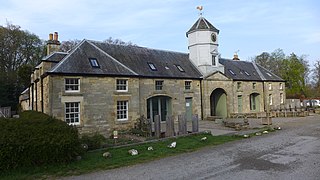Difference between revisions of "House of Falkland Stables"
| Line 6: | Line 6: | ||
| style="width:50%"| '''Name''' || House of Falkland Stables | | style="width:50%"| '''Name''' || House of Falkland Stables | ||
|- | |- | ||
| − | | '''Address'''|| Falkland Estate KY15 7AF | + | | '''Address'''|| Falkland Estate |
| + | |- | ||
| + | | '''Postcode'''|| KY15 7AF | ||
|- | |- | ||
| '''Other names'''|| The Stables | | '''Other names'''|| The Stables | ||
|- | |- | ||
| '''Date'''|| 1822 | | '''Date'''|| 1822 | ||
| + | |- | ||
| + | | '''Architect''' || John Swinton; Donald A Stewart | ||
|- | |- | ||
| '''OS grid ref''' || NO 24655 7495 | | '''OS grid ref''' || NO 24655 7495 | ||
| Line 24: | Line 28: | ||
__NOTOC__ | __NOTOC__ | ||
'''House of Falkland Stables''' were built to house the horses and carriages for [[Nuthill House]] and later the [[House of Falkland]] and also provide accommodation for the coachman. | '''House of Falkland Stables''' were built to house the horses and carriages for [[Nuthill House]] and later the [[House of Falkland]] and also provide accommodation for the coachman. | ||
| + | |||
| + | More recently they have been restored to house the Falkland Centre for Stewarship, including a cafe, exhibtion gallery and offices. | ||
==Listing description== | ==Listing description== | ||
Revision as of 12:21, 9 January 2021
House of Falkland Stables were built to house the horses and carriages for Nuthill House and later the House of Falkland and also provide accommodation for the coachman.
More recently they have been restored to house the Falkland Centre for Stewarship, including a cafe, exhibtion gallery and offices.
Listing description
John Swinton 1822-4; later additions, Donald A Stewart, from 1889. 2 storey, 9-bay, classical former stable block forming quadrangle with prominent timber cupola to S. Coursed, squared rubble to principal elevation (S); rubble to other elevations. Piended dormers breaking wallhead to E and W.
PRINCIPAL ELEVATION TO S: symmetrical. Central, slightly advanced, pedimented segmental archway with 2-stage, octagonal timber weatherboarded tower above. Slatted timber entrance doors with shouldered arched windows to either side flanking central archway. Advanced 2-bay outer bays.
COURTYARD: some segmental-arched openings with 2-leaf part-glazed doors. Small upper level segmental-arched window openings. Forestairs to N and S elevations. Circular cast iron horsetrough with 4 stylised horse legs as supports.
Predominantly 3-over 3- and 6-over 6-pane timber sash and case windows. Rooflights. Grey slates. Ridge stacks. Cast iron rain water goods. Wallhead stacks.
INTERIOR: (partly seen, 2010). S range with timber stalls with metal end posts; hay baskets; cobbled floor; simple cornicing. Offices to N with timber panelling.
Statement of Special Interest: This is a fine example of a classically designed courtyard plan stable complex, situated close to the entrance to the House of Falkland Estate. ...[1]
Further references
Notes
Gallery
[Click on a picture below to see the image full-size]

